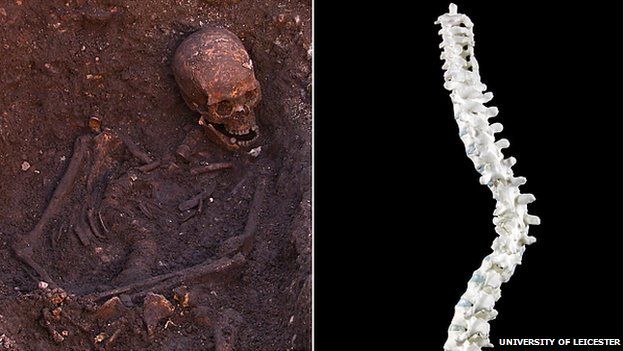Richard III: Team rebuilds 'most famous spine'
- Published

Richard's body was jammed into a small grave but digital scans have allowed the spine to be reconstructed
Richard III's bent spine would have left him inches shorter, but able to function well, researchers have found.
Shakespeare depicted Richard as physically and mentally grotesque, a view rejected by modern supporters.
When his skeleton was found under a Leicester car park in 2012, the marked curve in its vertebrae was the first clue it could be the infamous monarch.
But the University of Leicester believe his spine's subtly spiral twist could have been disguised with clothing.
After Richard III died at the battle of Bosworth in 1485 and was hastily buried under a Leicester church, his name was blackened by the new Tudor dynasty.
'Comely enough'
But the University of Leicester said the study meant "now everyone can explore the true shape of one of history's most famous spinal columns".
The findings, published in The Lancet, external, detail how CT scans of the vertebrae were used to create accurate copies from a 3D printer.
Shakespeare's Richard is warped in mind and body
Dr Piers Mitchell, from the University of Cambridge, explained how these showed the exact nature of the curve, known as a scoliosis.
"The bones are all a slightly different shape at the most curved part of his spine (compared to) that you would expect to see.
"We have been able to put those bones back together because the only way those bones could fit together in life would be in the form of a scoliosis," he said.
University of Leicester osteoarchaelogist Dr Jo Appleby, of the university's School of Archaeology and Ancient History, concluded: "Although the scoliosis looks dramatic, it probably did not cause a major physical deformity.
"This is because he had a well-balanced curve. The condition would have meant that his trunk was short in comparison to the length of his limbs, and his right shoulder would have been slightly higher than the left, but this could have been disguised by custom-made armour and by having a good tailor.
"There is no evidence that Richard had a limp as his curve was well balanced and his leg bones were normal and symmetric."
Dr Phil Stone, chairman of the Richard III Society, said: "History tells us that Richard III was a great warrior.
"Clearly, he was little inconvenienced by his spinal problem and accounts of his appearance, written when he was alive, tell that he was 'of person and bodily shape comely enough'".